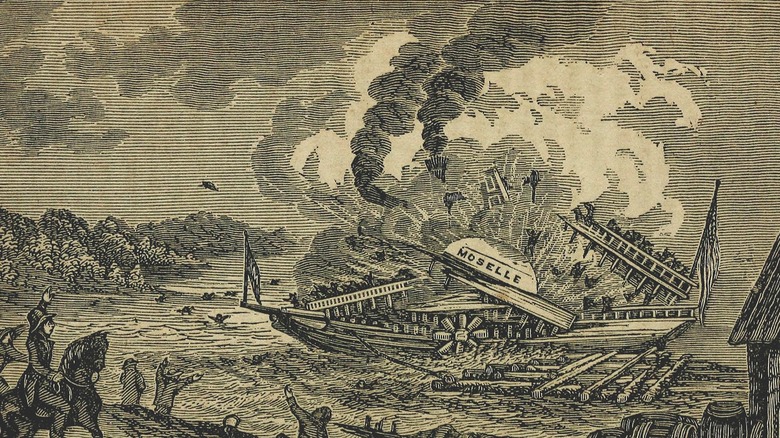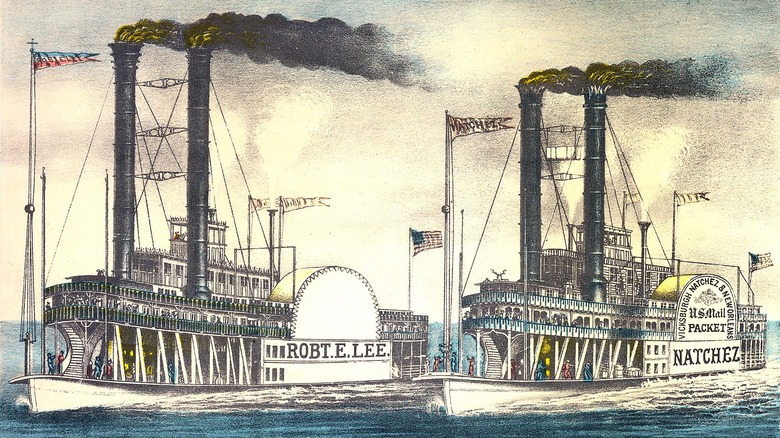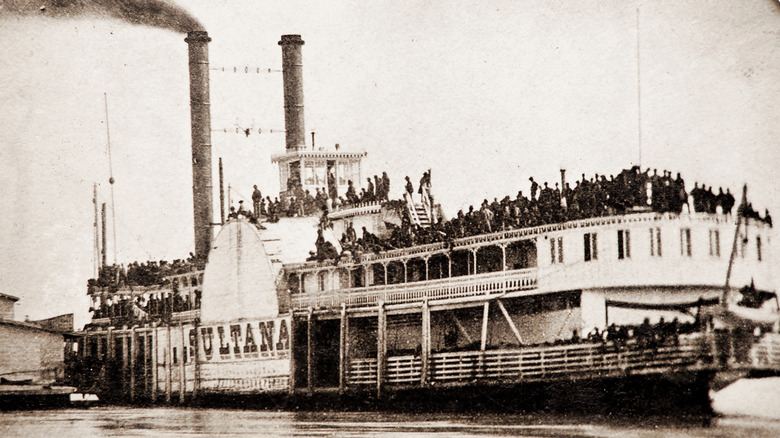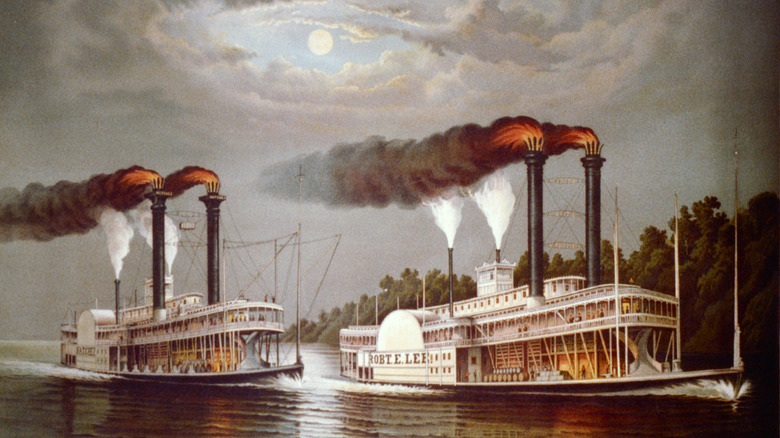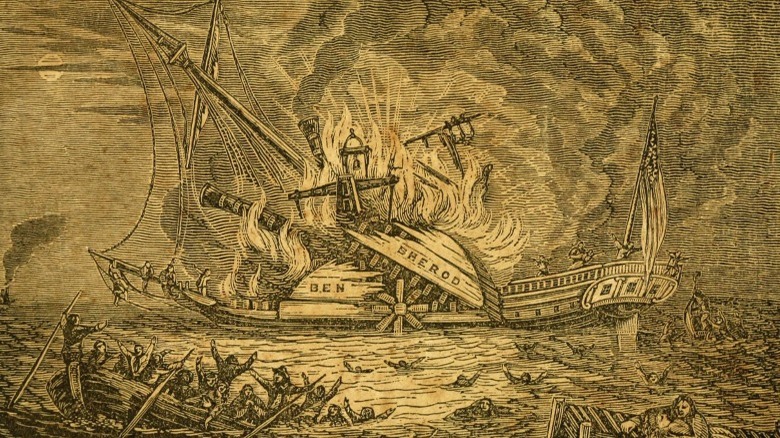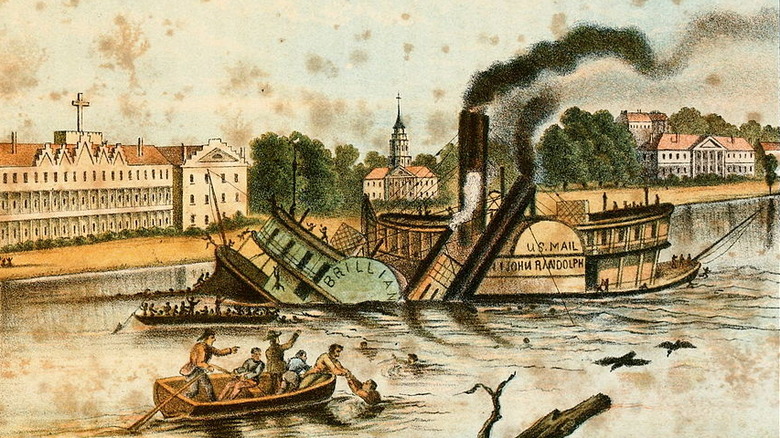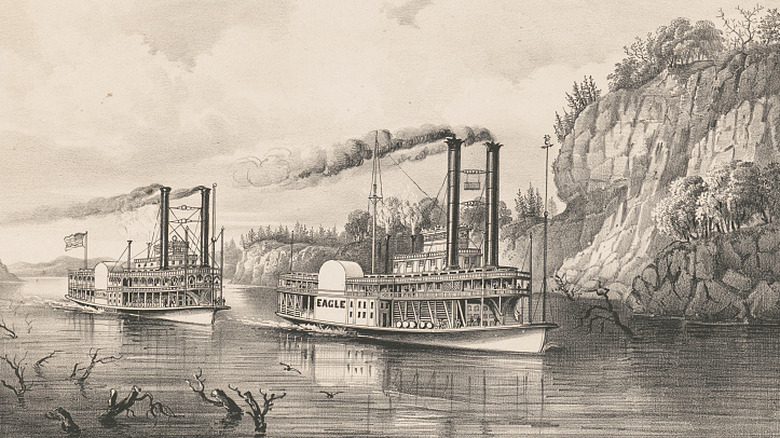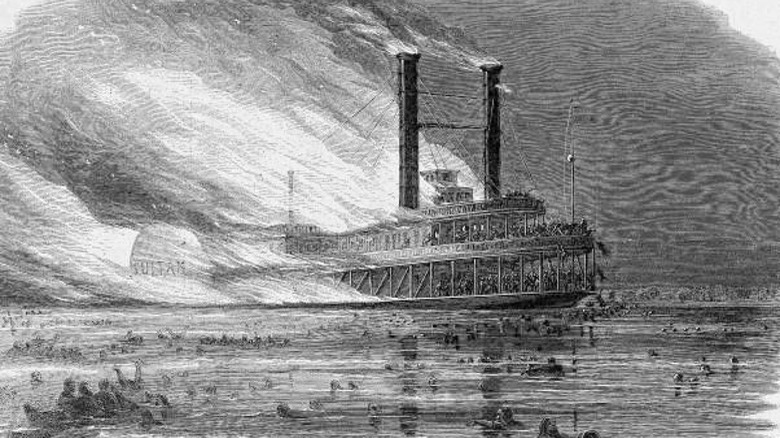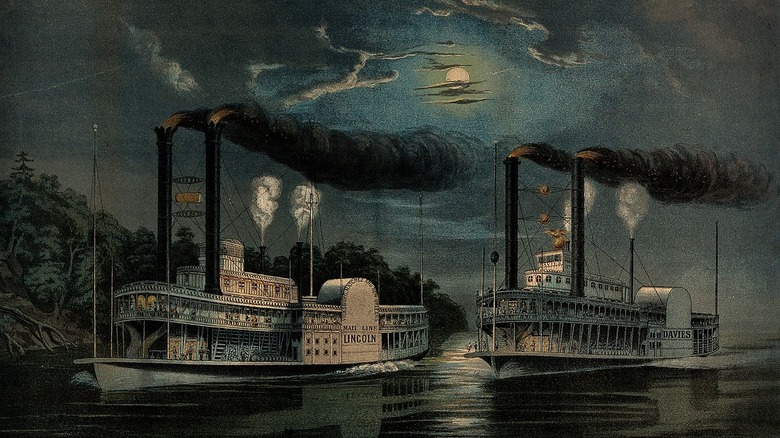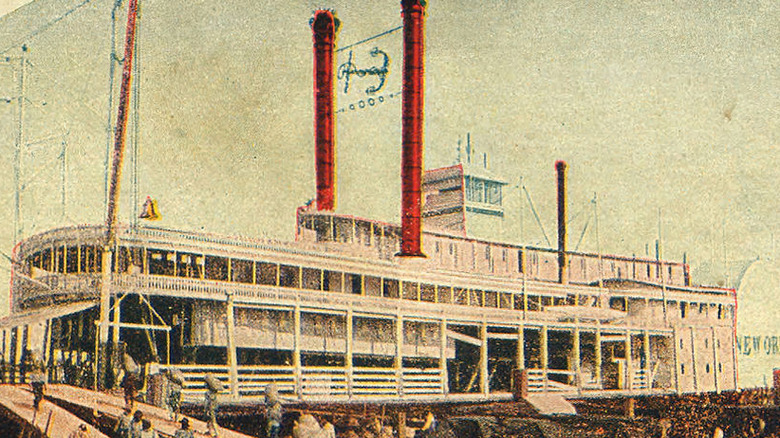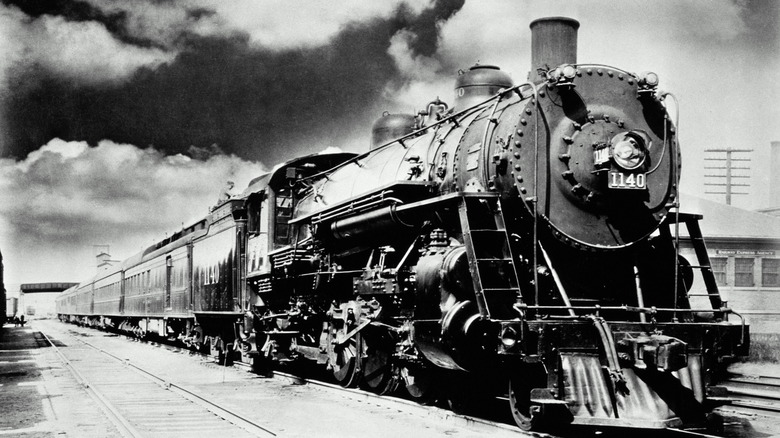The Dark Truth About America's Deadly Steamboat Races
When you think about people racing fast vehicles, the first image to come to mind might be fancy sports cars. Motorcycles or planes might be on that short list, too. But back in the mid-19th century, there was a very different (yet equally dangerous) form of vehicular competition: steamboat racing.
Steamboats in general were a really big deal around the turn of the 19th century, first being seen in the late 1780s and emerging as a new and viable form of transport as the 1800s rolled around. Despite not being the actual inventor, Robert Fulton is largely seen as the man to thank for this new phenomenon; dubbed the "father of steam navigation," Fulton was the one to successfully commercialize steamboats and the services they could provide, playing a large part in turning the steamboat into a hallmark of 19th-century transportation.
And with the inception of a new and popular form of travel came the introduction of sport and competition. In fact, it didn't take long for racing to enter the picture, with Fulton himself racing one of his ships in the summer of 1811. That race didn't have an ending that most people would probably call exciting — the two captains called it a draw after a minor collision — but the concept of steamboat racing had been born. Competition can be a dangerous thing, though, and the sport of steamboat racing shows us exactly why.
Steamboat racing was a spectacle
Despite the dangers it would prove to present, steamboat racing became something of a beloved American pastime.
Mark Twain himself actually sums up the fascination with steamboat racing with the kind of aplomb you'd expect of a celebrated writer. In "Life on the Mississippi," he artfully describes how it felt like the boats themselves were straining to win the race, stressing their hulls and spewing a combination of smoke, steam, and sparks into the air. The description paints this race as a breathtaking affair, and Twain further sells this depiction with a quick comparison: "Much the most enjoyable of all races is a steamboat race ... A horse-race is pretty tame and colorless in comparison."
Twain wasn't the only person who had plenty of kind words to say about steamboat racing. A bunch of writers would look forward to recording their experiences at these races, but there's a decent chance that quite a few of them took to exaggeration. It was more about telling a good story than accurately recording the facts, and that kind of mindset made it far easier to try and turn boats and their captains into legendary heroes. That said, those exaggerated accounts of spectacular contests did likely build up the hype around steamboat races, drawing more people and larger audiences toward them over time.
Passengers actively encouraged racing
If the colorful and exciting accounts are anything to go by, steamboat racing was quite the spectator sport — the sort of thing that brought people swarming to the river banks to watch the contest. But it wasn't just the audience that was especially invested in what was going on. The passengers on board the racing boats were a strangely integral part of the sport.
As steamboat racing gained traction, people began seeing the races as an integral part of every river voyage. Races were expected, and passengers would actively hope to be on a boat during a race so they could celebrate the victory and feel a vicarious sense of pride.
But it went even further than that, with passengers actually trying to ensure that their boat would win. An account by Carl Schurz (via Louis C. Hunter's "Steamboats on the Western Rivers") describes one such situation, wherein the passengers saw their steamboat being passed by another. They took their concerns to the captain, asking if he'd actually let his vessel lose the impromptu race. At the moment, the captain seemed reluctant to give in to their desire, but it wasn't long until he called for the boat to put on more speed. The passengers were thrilled and stressed in equal measure, with some of them even helping the crew load fuel.
Reputations were on the line
While it's true that one of the factors that contributed to the rise of steamboat racing was the excitement of audiences and passengers alike, it's hard to say whether the sport would've grown to the level it did if there wasn't something in it for the owners and captains of the boats.
Generally speaking, that benefit was related to business. On one hand, if two different boats were headed to the same port at the same time, whoever arrived first would naturally get to cherry-pick the cargo and passengers waiting at the landing. They could curate exactly who and what was brought on board, which, by extension, also allowed them to mold and shape their reputation. But reputation wasn't only gained by picking up certain types of cargo and passengers; on the contrary, the races themselves were, in effect, just big marketing ploys. Audience members and passengers would begin to recognize specific boats and play favorites — really, it's not all that different from how modern-day fans idolize their favorite athletes. Reputation became a way to rise through the ranks.
Then, of course, there was also the matter of personal pride. Steamboat racing became popular enough that captains began to measure their worth by their success in racing. Winners were often awarded a set of antlers to mark their victory, and a steamboat that was said to "hold the horns" had essentially achieved celebrity status.
Racing encouraged dangerous situations
There's a lot to be said for the spirit of competition. It's often seen as a positive thing, pushing people to be their best and overcome challenges, but it has also pushed people in a very different direction — toward cutting corners and sacrificing safety in the name of victory. And the latter is the reputation that steamboat racing began to gain over time.
One of the most notorious dangers when it came to steamboat races came from the fact that, true to their name, these vessels ran on steam power supplied by boilers. Those boilers had safety measures in the form of valves that could open to let off excess pressure, but steamboat crews realized they could get around that limitation. By tying down those safety valves and sealing them up, the pressure inside the boiler would rise, and the boat would gain speed. To make things even more worrisome, crews would often feed the boilers even further, tossing in every flammable substance at hand. But increased pressure and heat don't exactly make for safe racing conditions, and the boilers weren't made to be used at such extreme conditions. It wasn't unheard of for the boilers to burst from the increased strain, and the ensuing explosion would kill many of the passengers and crew members on board — either directly from the force of the explosion or resulting fires, or indirectly, as people would try to jump to safety, only to drown.
Explosions weren't the only dangers
Steamboat races entered the American consciousness largely as an exciting spectator sport, but eventually (and despite their continued popularity), they did start to verge on infamy. And though steamboat racing and steamboat explosions were becoming intrinsically linked, explosions were just one of the hazards of racing these ships.
For starters, there were the natural hazards: Riverbeds could contain any number of obstacles, including rocks and tree roots, and a boat colliding at high speed with any of those rough surfaces could potentially spell disaster. Or there was always the possibility of collisions with other boats. Some of those collisions could be ascribed to accident, especially as the waterways began seeing more traffic. But some of those crashes might not have been so innocent, with captains intentionally ramming their boats into each other, trying to ensure that neither could grow their lead in a race. Damage was usually pretty minimal in those cases, but the tactic doesn't exactly speak to a high regard for safety.
Then, there were also those who were trying to figure out the science of speed, even at the cost of potential safety. One of the theories floating around at the time posited that a more flexible hull on a boat could lead to greater top speeds. This theory wasn't especially well supported and wasn't fully proven, but common sense did say that this greater flexibility meant the boat could deform and break more easily, should a collision happen.
Passengers knew about the risks
The typical picture of steamboat races was one of excitement, of passengers and spectators cheering and hoping for the thrill of victory — or even for the morbid spectacle of minor disaster, in some cases. People seemed to live for the excitement, despite the possibility of danger — or maybe blinded to it, whether intentionally or not.
But not everyone shared that particular mindset, and the dangers of being on board a racing steamboat were well known, even at the height of the sport's popularity. Accounts recalled in Louis C. Hunter's "Steamboats on the Western Rivers" explain that, sometimes, passengers on steamboats had absolutely no desire to take part in a race, and when they were confronted by a situation where a nearby boat might want to challenge them, they would go to the captain and request that they not rise to that challenge.
Unfortunately for those particular passengers, though, they usually found themselves to be in the minority. With many of their peers clamoring for excitement, they typically found their opinions to be completely drowned out, and they would simply have to accept that their lives were in potential danger, often hiding in corners of the boat farthest from the boilers.
Steamboat explosions were devastating
The generalizations and summaries of the dangers of steamboat operation and racing paint a grim picture, but there were specific incidents and details that really brought those dangers to the forefront.
When it comes to the worst maritime disaster in all of American history, you can look at the sinking of the steamboat the SS Sultana in April 1865, which led to the deaths of an estimated 1,800 people, many in the initial boiler explosion. Bodies were found floating in the river for weeks following the tragedy, which also resulted in the court martial of the boat's captain for knowingly taking on nearly 2,000 more passengers than the vessel's legal maximum capacity.
The SS Sultana wasn't the explosion that led to legal changes in the operation of steamboats, though; that was the tragedy of the Moselle, a ship known and praised for its exceptional speed. It had only been in operation for about a month when, on April 25, 1838, its boilers suddenly burst, perhaps as a result of the strain put on them from races. The nearby crowd watched in horror as passengers were flung from the deck, some into the water and some into the buildings on the riverbank, and the boat was reduced to splinters. Approximately 150 people died in that accident, and when you consider that over 1,800 people died in steamboat accidents between 1816 and 1848, it was clear that something would have to change.
How deadly were the races themselves?
To be entirely clear, all steamboat disasters — regardless of the exact details and circumstances that caused them — were tragic, often involving the losses of hundreds of lives. However, there is a somewhat strange detail worth addressing.
Many members of the public tended to associate steamboat races with dramatic and deadly climaxes, such as explosions. As time has passed, that's the perception that has managed to take hold in a lot of popular writing. But there's a chance that the technical numbers don't entirely support that. According to Louis C. Hunter's "Steamboats on the Western Rivers," it's actually pretty difficult to find first-hand reports from the time that describe explosions taking place during a race. It wasn't necessarily unheard of, but, in a way, racing became something of a scapegoat — something to point to when looking for a reason behind steamboat explosions. In reality, though, more of those explosions happened during normal, everyday operations. A report from the time even lists 97 different steamboat explosions, and of all of them, only one was directly linked with racing. In short, the deadliness of steamboat races is something that was exaggerated, even back then.
But none of that changes what people expected of races at the time. The public imagination was enamored with this morbid fantasy of exploding steamboats, and that potential for grim spectacle was one of the reasons so many people lined the riverbanks to watch a race.
[Featured image by Wellcome Images via Wikimedia Commons | Cropped and scaled | CC BY 4.0]
The government was hesitant to act
As the dangers of steamboat racing grew more and more prominent, you would think that, at some point, someone might have decided to step in and do something about it. That would make a lot of sense — people's lives were literally at risk — but the reality was that these races were allowed to carry on for years without any sort of regulation.
The reason for that lies largely with the federal government's stance on the steamboat industry. Throughout the 19th century, steamboats were still considered relatively new, and beyond that, many officials believed that steamboats were the future — a vital industry that would bring wealth to the country. As such, that industry should be nurtured; some thought that federal interference of any kind would stifle the growing market, and that would do no good for the economy. So the conclusion that the federal government came to, at least for a time, was that it should simply sit back, watch, and hope the problem worked itself out. They believed that the profits lost to explosions, along with simple common sense, would be enough to regulate the steamboat industry.
In the end, doing nothing accomplished exactly that: nothing. While there were a few attempts made by state governments to enforce some level of regulation on steamboats, they weren't particularly effective. With trade routes usually crossing over state lines, local safety standards could only do so much.
[Featured image by Absecon 49 via Wikimedia Commons | Cropped and scaled | CC BY-SA 3.0]
Legislation finally became necessary
All that really came from the federal government sitting back as more steamboats exploded was a persistent problem that wouldn't go away on its own. And as major explosions continued to make headlines in the news, the government finally decided to take a step toward making steamboats safer.
The first step came in 1838, though it was hardly a comprehensive solution. This particular piece of legislation required that all steamboats be held to at least some safety standards. They needed to undergo regular inspections and employ skilled engineers, as well as carry the safety equipment you would expect on a water-based vessel. But the problem was in the vague language. There was no standard for what constituted adequate safety, and the actual skill required of an engineer or captain wasn't specified, nor were there any explicit descriptions or measurements to explain what was considered unsafe. To top it off, there was no central body to enforce any of these rules.
Fortunately, those issues were later addressed with the Steamboat Act of 1852, which effectively fixed all of the loopholes in the 1838 legislation. An official government agency was finally founded to determine what these stricter regulations should be, and to adapt them as needed. In the years to follow, the number of steamboat explosions began to fall.
Steamboats were doomed for other reasons, too
Federal legislation and the enforcement of stricter regulations did play their part in the declining number of steamboat accidents — that much is likely true. However, history isn't always so simple as one act of legislation killing an entire industry. On the contrary, the end of the era of steamboats (and their races) came as a result of quite a few factors.
One of those factors was external. As the 19th century progressed, a new form of transport started to emerge: railroads. And those railroads — not steamboats — suddenly seemed like the true way forward, offering benefits that boats just couldn't. Schedules could be more reliable. Companies could own the land their railways were built on — in contrast, no one owned the rivers, which forced competition. And there was more potential for expansion, as rails could be built anywhere while rivers were stationary. Steamboats were just naturally on their way out.
But the steamboat industry even had its own internal problems. Competition had grown to unsustainable levels, with steamboat owners harassing their competitors and even their customers, trying every dirty tactic they could think of to generate more business. Prices were regularly slashed to be more appealing to customers, and cut-throat tricks meant that steamboats were sometimes driven to the brink of financial ruin, just to force a rival boat out of business. Even without the rise of railroads (and the looming Civil War), the business models employed by most steamboats would've likely proved untenable over time.
